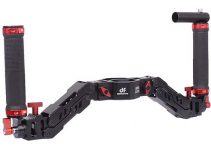One of the less known features of Blackmagic Design’s DaVinci Resolve is the ability to stabilize shaky footage. Some people are seriously questioning whether the Stabilizer in Resolve performs as good as the Warp Stabilizer in Premiere Pro, for example, however if you’re on the rush, and DaVinci Resolve is your only available option for the moment, this feature is worth trying.
Imagine a situation where you are with a client behind your shoulder, reviewing the color grading you’ve already done and suddenly you stumble upon a shaky footage. In the following tutorial, the filmmaker and colorist Alexis Van Hurkman will show us how to use DaVinci Resolve’s Stabilizer to remove some annoying wobble from your footage.
Image stabilization processing in Resolve consists of three easy steps. The first step is analyzing the clip; the second is choosing the stabilization settings you want, and the last one is clicking the Stabilize button to calculate the result. As with Object tracking you can choose which aspect of motion to stabilize, but this step must be done before the initial image analysis is done.
To access the Stabilizer, you should navigate to the Tracker palette. There is a second mode in the drop down menu where you can find the Stabilizer. Turn off any of the Analyze check boxes that correspond to axes that you don’t want to smooth. Inside the Tracker palette you need to push the Track forward button, thus Resolve will automatically analyze the whole shot. After the process is finished, the analysis of the clip will appear in the Tracker palette. Each line of the analyzes corresponds to the different settings of the stabilizing process such as pan, tilt, zoom, and rotation.
To fine tune the results from the stabilization process you will need to change the Strong and Smooth settings in advance. Both parameters control the overall process and dictate how much stabilization is applied to your clip. You can check Zoom to eliminate the black edges that may appear as a result of the repositioning of the image to reduce the unwanted camera movement. After the analyzing has been completed and you set the stabilization settings, you should go to the beginning of the clip and press the Stabilize button in the bottom left corner of the Tracker palette.
Supposing the blanking artifacts introduced at the edges of the frame are still there, you can easily remove them in the Sizing palette as well. You can manually zoom to get rid of the blanking in the frame and achieve the desired result. Whenever you make changes to the Stabilization Settings, you need to click Stabilize again to recalculate the result to your clip.
This simple technique will eliminate the need to use another NLE such as Adobe Premiere Pro or Apple’s Final Cut X to stabilize a single clip in particular situations. Even though DaVinci Resolve is known for its superb color correction abilities, this above example is another unambiguous proof that the platform is also designed to be an extremely powerful editor providing a plethora of powerful editing assets as well.
Disclaimer: As an Amazon Associate partner and participant in B&H and Adorama Affiliate programmes, we earn a small comission from each purchase made through the affiliate links listed above at no additional cost to you.




Terrific overview. I really appreciate this great tutorial. Thanks!
Sometimes when I use the Stabilizer, Davinci Resolve end up tracking a person as well, and it does all sort of tilt, rotation, pan and zoom. How do I control it so it can focus on keeping the background still instead of the person?
I realize it’s been 7 months since this was asked, but:
I believe you can use Set Point to define target(s) within the frame for Stabilization, just as you can with the tracker for node mask windows.
Maybe also try just initializing the tracking from a different frame that doesn’t feature the person so prominently?
the results are deceptive with resolve 12.5 trying to stabilize video. I tried to stabilise a timelapse video after noticing my camera was moved on some frames some 1 mm by the wind and davinci stabilizer couldn’t fix that.
What about stabilizing moving shots, such as when you’re doing a walk thru the park? Seems like Pan and Zoom go off the charts and Tilt gets pretty erratic after you change location from the original.
Try checking the Zoom checkbox located next to the “Strong” and “Smooth” controls (not the Zoom option for the tracker) before pressing Stabilize. I’ve had success by enabling that option, which automatically translates the adjusted image to fill the screen (although it has on at least one occasion left a black spot on the edge of the most heavily manipulated frames, so still double-check and compensate with global clip zoom in Inspector if needed).
Also try only enabling the tracker for the types of movement you intend to correct. I stabilized a shaky handheld clip today that was shot from a stationary position, hence I didn’t need to track zooming; I turned that off and left the other trackers on, and it seemed to help me achieve the desired correction.
The best free version is DeShaker as a plugin for VirtualDub, the best around, as you have much, much, more control for moving, extreme zooming stabilizing and shaky footage!
It’s for power users, so no Pro Dad Mercalli/Power director/Vegas dumbed down settings…